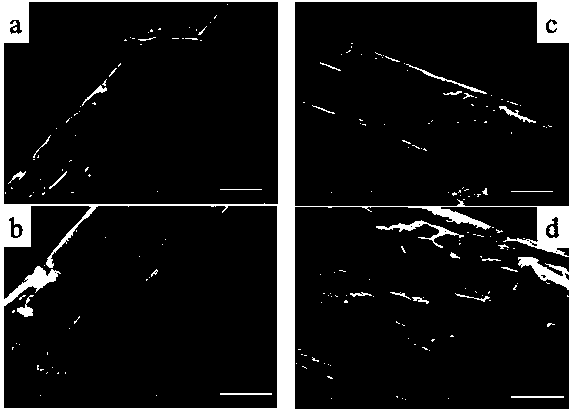Combined pretreatment process for efficiently and environmentally friendly improving enzymolysis saccharification efficiency of lignocellulose
A lignocellulose and pretreatment technology, applied in the direction of biofuels, fermentation, etc., to achieve the effect of improving saccharification efficiency, enzymatic hydrolysis and saccharification efficiency, and mild treatment conditions
- Summary
- Abstract
- Description
- Claims
- Application Information
AI Technical Summary
Problems solved by technology
Method used
Image
Examples
Embodiment 1
[0024] ( ) The rice straw is dried and crushed, and the particle size is controlled to be 180-425 μm;
[0025] ( ) Lactic acid and choline chloride were mixed at a molar ratio of 4:1, placed in a shaker at 70 °C, until a completely fused colorless and transparent liquid was formed, and then stabilized for 10 minutes before being taken out for use;
[0026] ( ) into rice straw at a content of 10% (W / W), adding the above ( ) in the eutectic solvent, and vibrated and mixed in a shaker at 70 °C for 48 h, filtered and cleaned the filter residue with distilled water until the pH of the cleaning solution was neutral, and dried the cleaned filter residue at 55 °C. Obtain rice straw samples after NADES treatment;
[0027] ( ) Put the NADES-treated rice straw in a container of appropriate size, add 4% / 6% NU solution at a solid-to-liquid ratio of 1:20 (g / mL), and place it in a constant temperature environment of 25 °C for 4 hours Finally, filter and wash the filter residue wit...
Embodiment 2
[0031] ( ) The rice straw is dried and crushed, and the particle size is controlled to be 180-425 μm;
[0032] ( ) Lactic acid and choline chloride were mixed at a molar ratio of 4:1, placed in a shaker at 70 °C, until a completely fused colorless and transparent liquid was formed, and then stabilized for 10 minutes before being taken out for use;
[0033] ( ) into rice straw at a content of 10% (W / W), adding the above ( ) in the eutectic solvent, and vibrated and mixed in a shaker at 70 °C for 48 h, filtered and cleaned the filter residue with distilled water until the pH of the cleaning solution was neutral, and dried the cleaned filter residue at 55 °C. Obtain rice straw samples after NADES treatment;
[0034] ( ) Put the NADES-treated rice straw in a container of appropriate size, add NU solution with a concentration of 4% / 6% at a solid-liquid ratio of 1:20 (g / mL), and place it in a constant temperature environment at 4°C for 4 hours Finally, filter and wash the ...
Embodiment 3
[0038] (a) Rice straw is dried and crushed, and the particle size is controlled to be 180-425 μm;
[0039] ( ) Lactic acid and choline chloride were mixed at a molar ratio of 4:1, placed in a shaker at 70 °C, until a completely fused colorless and transparent liquid was formed, and then stabilized for 10 minutes before being taken out for use;
[0040] (c) Add rice straw at a content of 10% (W / W), add the above ( ) in the eutectic solvent, and vibrated and mixed in a shaker at 70 °C for 48 h, filtered and cleaned the filter residue with distilled water until the pH of the cleaning solution was neutral, and dried the cleaned filter residue at 55 °C. Obtain rice straw samples after NADES treatment;
[0041] ( ) Put the NADES-treated rice straw in a container of appropriate size, add 2% / 3% NU solution at a solid-to-liquid ratio of 1:20 (g / mL), and place it in a constant temperature environment at 25 °C for 4 hours Finally, filter and wash the filter residue with distilled ...
PUM
| Property | Measurement | Unit |
|---|---|---|
| particle diameter | aaaaa | aaaaa |
Abstract
Description
Claims
Application Information
 Login to View More
Login to View More - R&D
- Intellectual Property
- Life Sciences
- Materials
- Tech Scout
- Unparalleled Data Quality
- Higher Quality Content
- 60% Fewer Hallucinations
Browse by: Latest US Patents, China's latest patents, Technical Efficacy Thesaurus, Application Domain, Technology Topic, Popular Technical Reports.
© 2025 PatSnap. All rights reserved.Legal|Privacy policy|Modern Slavery Act Transparency Statement|Sitemap|About US| Contact US: help@patsnap.com



